
F.O Ian Purssey shown with 450 Sqn RAAF P-40N OK-X FX709 'Go It Gertie'. Creti. July 44 (a town in the centre of Italy, not the Island). Photo I.Purssey via Dave Muir.
by Steve Mackenzie

F.O Ian Purssey shown with 450 Sqn RAAF P-40N OK-X FX709 'Go It Gertie'. Creti. July 44 (a town in the centre of Italy, not the Island). Photo I.Purssey via Dave Muir.
This airframe FX709 is very interesting because I like to call it 'the missing link' of P-40N camouflage with the RAF. I have said for decades that the majority of P-40Ns built against the RAF contracts came from the factory in standard USAAF colours i.e Olive Drab over Neutral Gray. The RAF then added a 3rd colour (Dark Earth) on the upper surfaces to give an approximation of the Temperate scheme which they preferred at that time for tactical fighters in Italy.
What makes it a 'missing link' is that it came from the factory with the Medium Green 42 scalloping along the edges of the flying surfaces. On the vertical tail one can see where the Dark Earth has been added post production, partially obscuring at least one of the Medium Green 42 patches. It also had a Sky Blue fuslage band when produced (many airframes show the remains of these, or in some cases still present in RAF service) which has been overpainted with RAF Dark Green, slightly different in tone to the original Olive Drab upper surfaces. The paintwork is very stained amd scratched (something I did not try to reproduce on my profile), also note a panel has been replaced just ahead of the wingroot (slight difference in colour and disruption to the pattern). Finally DK Decals do this scheme on their sheet 72080 (450 Sqn) for those interested.

P-40N OK-X FX709 'Go It Gertie'. Olive Drab and RAF Dark Earth uppersurfaces with Neutral Grey lower surfaces. There is Medium Green 42 scalloping along the front and back of all flying surfaces (overpainted in some areas by the Dark Earth added post production). A Sky Blue fuselage band has been painted out with RAF Dark Green. The fin tip has been overpainted with a dark colour, I used Dark Gray, it could also be a very dark Green.
Standard roundels of the period in six positions plus fin flashes. Codes (OK-X) are White, with a small 'X' repeated under the nose. Serials in Black and standard Red Desert Air Force spinner. The individual marking on the nose (likely to Port only) is White with Black detailing, carrying what is likely to be a Bronze Green bomb (usual colour for RAF bombs of the period). The wheel hub looks to be light grey (clearly not Olive Drab).

Overall view of OK-X FX709 'Go It Gertie'. Creti. July 44 showing many of the points discussed above. Photo I.Purssey via Dave Muir.
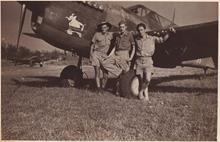 |
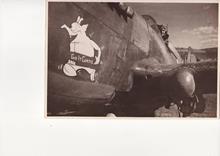 |
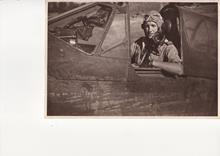 |
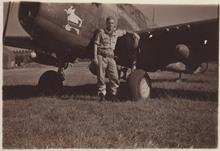 |
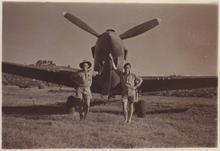 |
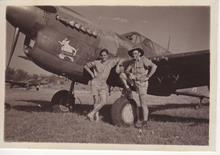 |
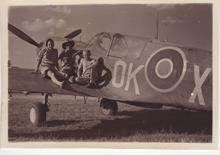 |
 |
Various images of Ian Purssey (and crew in some) with FX709. Photos I.Purssey via Dave Muir.
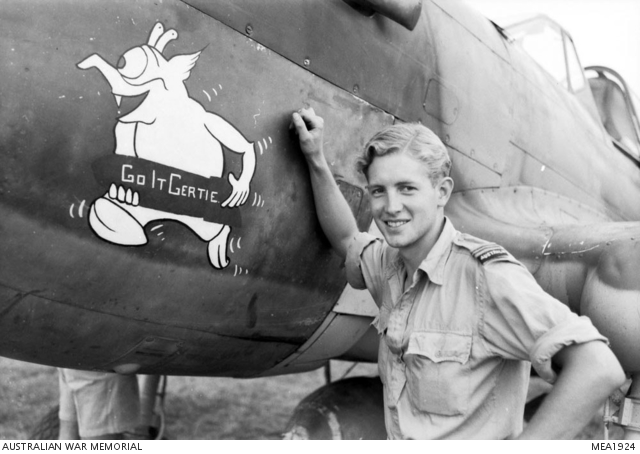
Creti. c. Jul-Aug 1944. Informal portrait of 425749 Flying Officer (FO) I. G. S. Purssey of Brisbane, Qld. Photo AWM MEA1924. Note that there are differences between this airframe and FX709 (lower surfaces except lower nose panel are light grey, a common repaint on RAF P-40Ns and there are differences in the camouflage pattern). This is clearly a successor to FX709, the lower nose panel (still in Neutral Grey) having been transferred across complete with it's individual badge. The AWM caption says May 1944 but that is clearly incorrect as the only period when 450 Sqn operated from the drome at Creti was 9 July 1944 to 28 August 1944.
Use the index button to return to the main issue 38/1 index.